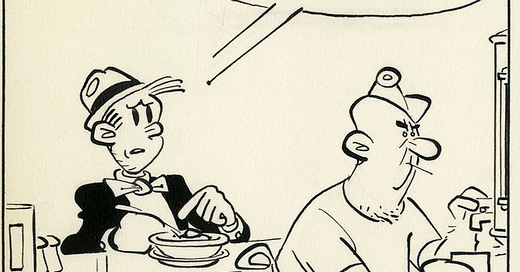Last week, I was reading Berton Roueché’s classic New Yorker story, “The Case of the Eleven Blue Men”, about an accidental mass poisoning in 1940’s New York City, when I came across a vivid description of the Eclipse Cafeteria, a cheap eating house in the worst part of the Lower East Side.
“It was about what I’d expected,” he told me. “Strictly a horse market, and dirtier than most. The sort of place where you can get a full meal for fifteen cents. There was a grind house on one side, a cigar store on the other, and the ‘L’ overhead.
That passage set off a cascade of food-based, semi-random thoughts, starting with a very clear mental image of Dagwood Bumstead complaining while Lou the Counterman, in a dirty apron, draws a cup of coffee.
Anyone over the age of 50 has probably seen this image a couple hundred times. Not surprising, since it’s been a running gag in Blondie for the past 90 years.
Yet, despite Lou’s hairy arms and bad food, that image is the wrong one for the real-life Eclipse Cafeteria. Dagwood is a middle class salaryman, a man with a beautiful wife, a decent job and a fine home in the suburbs, not a down-and-outer living in a flophouse in the Bowery. Lou’s lunch counter, as bad as it is, is not at the bottom. It’s in the middle. The Eclipse was several rungs down from any place Dagwood Bumstead would eat, that much is made clear in Roueché’s article. Also, let’s not forget that the fifteen cents the Eclipse was charging in 1944, would have been considered a cheap meal even fifty years earlier.
This all set me to thinking about cheap—really cheap—dining options in the first half of the 20th century, and how a historian (me) would approach that topic. It’s comparatively easy to figure out what the better restaurants were serving in, say, 1925 or 1935. Plenty of menus and newspaper reviews survive to tell us what was on their tables. But what did you get for your fifteen cents at the Eclipse Cafeteria in 1944? (Other than oatmeal accidentally laced with sodium nitrite.) That’s a more difficult question, and one I think I’m going to spend some time on in the coming weeks.
Of course, thinking about old-fashioned lunch counters and cheap cafeterias makes me wonder what happened to all of them? I’m guessing they were supplanted by fast food restaurants as the new bottom rung of the cheapest eats. Or am I assuming too much?
Also, while we’re talking about things that have vanished over the preceding decades, whatever happened to the boarding house? Once so common they were a staple in popular culture, now they’re nowhere to be found. Another topic worthy of exploration.
Recommendations
1. Speaking of reasonably priced dining, here’s a good short piece about the Spanish menu del día: Franco Invented the Modern Spanish Lunch. When I lived in Madrid, twenty some years ago, the fixed-price menu del día was the most reliable dining bargain in town, and it still is.
2. “We shouldn’t fool ourselves into thinking that because we went to Whole Foods and bought the organic product, we’re not participating in suffering and death.” Here’s an interesting and thoughtful interview with the writer Wyatt Williams about eating meat and killing animals.
3. Kitchen Projects is working on perfecting the chocolate chip cookie in a couple of iconic varieties. If you’re into highly detailed, thoughtful recipes this is for you.
4. Four and twenty blackbirds baked in a pie. David Shields has found a newspaper account of a living-bird pie being served to General Lafayette in 1825.
Apologies for the shortness of this newsletter, and for missing my appointed day on Thursday last. It’s the end of the semester and I’m swamped. I’ll be back this coming Thursday with something more substantial. Ciao!





Makes me think of Jacks Diner in Chico. Cheapest, best after bar food.
This brings back a lot of memories about the greasy spoon that, for many decades, was the only restaurant open year round in our small New England town.